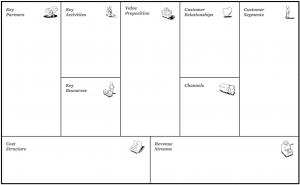Difficulty: Time:
What is a Business Model Canvas?
You never know when the best ideas can confront you. It could be at a cafe while you are sipping some tea or coffee with friends, or at a bar with a friend dreaming about the day you won’t have to slave away for someone elses dreams. We definitely have! This is where the Business Model Canvas can come in. It can be done either on a whiteboard, chalkboard, smartboard, or just the back of a coffee tanned napkin.
The Business Model Canvas or BMC is a way to structure and map a basic business plan. It is a great tool to get an overview of a business you are planning. In contrast to a business plan, it is much quicker and easier to complete. The great thing about it is it can be done absolutely anywhere. The only requirement…your imagination and creativity!
What is a Business Model Canvas used for?
The BMC is gaining popularity because of its lean structure. Many entrepreneurs are using it to innovate their business models, or create new ones.
Traditional business plans are lengthy, eye sores which may take a great amount of time for someone to write up. The BMC is much leaner, it puts the spotlight on exactly what is driving the business and what isn’t necessary. Also, it is much easier to tweak the model and try new things, see how different ideas clash or complement one another, as they can all be seen on one single page or board. And lastly, its understandable. It will be much easier to point out the key details as well as present your vision to your team.

How do you use it in practice?
Brief overview of each element:
Customer Segments: Who are they, What do they want? Build customer profiles here.
Value Proposition: Why would customer use or buy the product or service?
Channels: Where will you promote the value, sell it, and how will you deliver it? How will you reach your customer segments?
Customer Relationships: How will you build relationships, keep them and grow them, throughout the customer journey?
Revenue Streams: How will you earn money from the value provided, where will the revenue come from?
Key Activities: What activities will you engage in to make the business model work?
Key Resources: What unique resources do you have in order to have a competitive business?
Key Partnerships: What partnerships can you leverage to save costs or time to focus on your key activities?
Cost Structure: What will your main costs drivers be? What are the main costs that you will have in order to provide the product or service?
Step 1: Customer Segments
You should really take you time here. Depending on your resources close at hand, we would even recommend doing some field research to answer the following questions. This is one of the more important elements of the business canvas, because if you know your customer everything else will be smooth sailing.
Customer Dimensions: do you have just one customer or do you have a multi-sided market. Many of your products and services will have one dimension, but if you were a newspaper you would have two: the reader and the advertisers.
Customer Profiles: Next is to dive a bit deeper and look at the micro-view of your customer. You should be able to build profiles for different customers who may be interested in your products. Close your eyes, visualize your customer. What do they think? How do they look? How old are they? What kind of problems are you solving for them? If you are having a hard time with this, then narrow down your represenative group, or sample group, and discuss it with them or go observe them in action.
Step 2: Value Proposition
Here you will narrow down the problems that your customers have, or what needs are you fulfilling. Here also, really take your time and narrow down what is unique about your value proposition and why your customer profiles would buy into your vision. If you have a whole bunch of them, write them down on the back of the paper or on the side of the whiteboard and after you have a collections start to rank them with the most critical ones. Remember though, these value propositions should link to the customer profiles you have created in step 1.
Step 3: Channels
The channels should include different solutions you have to reaching your customers. Whether it is your own website to generate sales, or various advertising tools (Facebook advertising, Google AdWords) to gain attention. But, be aware it also includes third parties who you may contract out to in order to service the product once it needs repairs. Here again, you should be able to link the channels to each customer profile. How will you reach your customers. Even though your product IS the best the world has ever seen, if no one interested knows you exist then you are just like the fallen tree in the empty forest.
Step 4: Customer Relationships
How will your customer connect with you? How do you communicate with them during their customer journey. Do you have a dedicated sales person they speak with, do they have their own account manager? Will you treat all customers the same, or do you only have resources for your AAA clients. Or will you be a champion of personal support and treat all customers as if they are your only.
Step 5: Revenue Streams
Great! You are almost halfway done! Now comes the best part, the $$$! Where will your revenue streams come from? This is fairly simple, you should be able to link customer segments and their respective value proposition and generate a list of revenue streams.
Step 6: Key Activities
The key activities are basically also closely tied to the value proposition. Each proposition has certain activities that you must engage in to provide value to the customers. If you are a manufacturer of certain products, it would probably include engineering expertise, R&D, or learning new techniques in order to produce higher quality. This really depends on the value that you are proposing to the customers.
Step 7: Key Resources
Your key resources would consist of strategic assets that you require in order to support the key activities. The resources can range from key talent that you may have to the infrastructure you own. Talent can be your human resources, but it can also be the intellectual property you have accumulated from past business activities. Infrastructure on the other hand can be either physical or virtual. Amazon for example, you could say has a physical and virtual infrastructure. They have both massive amounts of warehouses, but also a vast virtual platform in order for their business to function.
Step 8: Key Partnership
We are almost there! We hope that at this point, the BMC has helped you view your business in a new light, or sharpen the focus of certain key areas in question.
Key partnerships are an important way to engage in your key activities. But, your key activities may fall outside of the scope of the business you are in. Maybe you have partners who provide those services to you, or you could find them? Here you should focus on those key activities which you may have or need to find Partners for.
Step 9: Cost Structure
At this point you should already have quite a decent understanding of your (potential) business. A few steps prior you have evaluated how your key activities drive you value proposition and then lead to revenue. Now we must do the same for cost drivers. What are the costs that you foresee in running this business? Are they directly related to providing your value propositions? Are they fixed or variable costs? Will they be fixed, grow linearly or worse throughout the business scaling process?
Congratulations, you have just finished your Business Model Canvas. In the following section we will provide some suggestions and ideas of what you can now do with it.
Next Steps
First, ask yourself and your team if it makes sense. Are there areas where you can go back and narrow the elements down or adjust them? Could it be understood by someone who isn’t part of the company?
The business model canvas is a great place to start thinking about your business. But, we strongly suggest that you also take a look at your competitive environment. Your current competitors and your future ones will definitely be looking to analyze you as well. We suggest to take a look at Michael Porter’s Five Forces model and then come back to see how your canvas can either be enhanced or changed.
If you feel you need additional guidance or consultation, drop us a mail privately or comment below. Thanks for reading!








